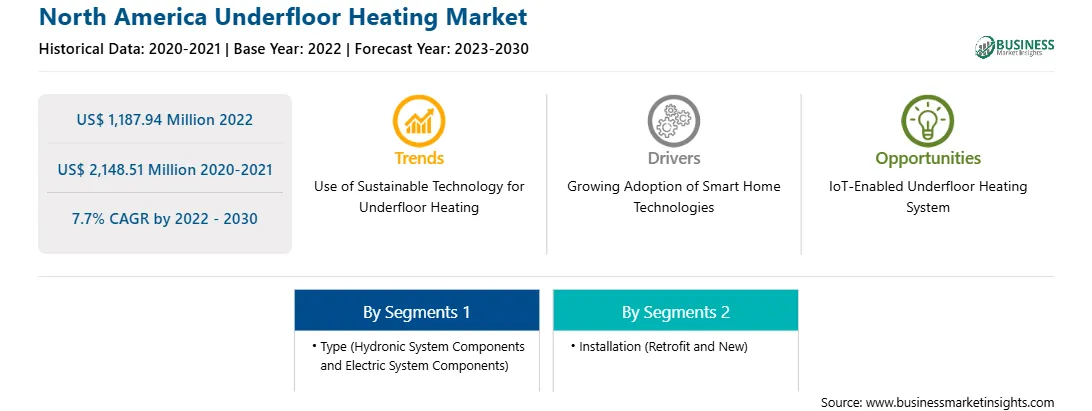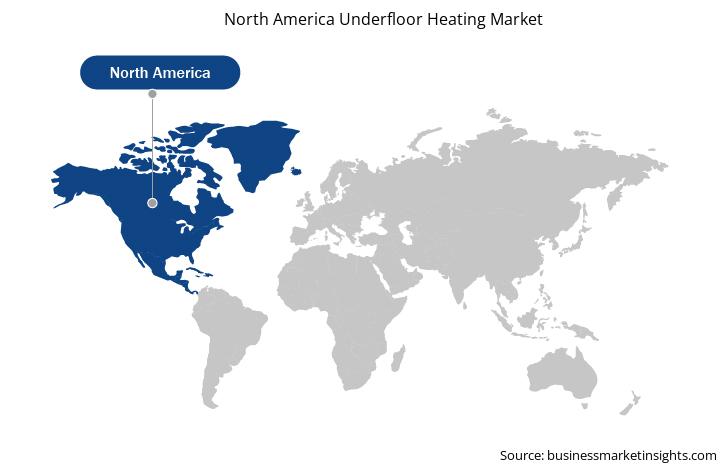The North America underfloor heating market was valued at US$ 1,187.94 million in 2022 and is expected to reach US$ 2,148.51 million by 2030; it is estimated to register a CAGR of 7.7% from 2022 to 2030. Increasing Investment in Construction Industry Fuels North America Underfloor Heating Market.
Underfloor heating is becoming more and more popular and being adopted in the colder regions of countries such as the US, China, and India, where fast development in the building sector also fueling the underfloor heating market expansion. Due to the wide range of uses for underfloor heating such as maintaining of consistent temperature and improve air quality, the existence of semi-desert and desert climatic conditions in many countries worldwide is expected to impact the underfloor heating market growth positively, as during the night in deserts the temperature fall below minus. The growing investment in the construction industry and the increasing spending power of individuals to improve living standards are projected to favor the underfloor heating market. The construction industry stands as a foundation of economic growth and societal progress. It plays a pivotal role in shaping the physical landscape of communities, fostering job creation, and propelling innovation. In today's rapidly evolving world, infrastructure demands are outpacing the pace of investment, economic potential, and quality of life. Thus, several governments and other entities across the world are investing in the construction industry-both in the commercial and residential sectors. For instance, as of October 2023, Single-family homebuilding in the US had a robust resurgence in September 2023, driven by demand for new construction amid a lack of previously owned homes. However, the surge in mortgage rates, reaching the highest level in almost 23 years, could potentially slow down this momentum. According to the US Commerce Department, single-family housing starts, which make up the majority of homebuilding, rose by 3.2% to a seasonally adjusted annual rate of 963,000 units in September. This figure was revised from the previously reported 933,000 units in August 2023. Overall, housing starts increased by 7.0% to 1.358 million units in September 2023, slightly below economists' expectations. The US government provides support to the construction sector by enhancing the competitiveness of American building goods, chemicals, and metals in global markets. The growth in construction industry is expected to fuel the underfloor heating market.
Strategic insights for the North America Underfloor Heating provides data-driven analysis of the industry landscape, including current trends, key players, and regional nuances. These insights offer actionable recommendations, enabling readers to differentiate themselves from competitors by identifying untapped segments or developing unique value propositions. Leveraging data analytics, these insights help industry players anticipate the market shifts, whether investors, manufacturers, or other stakeholders. A future-oriented perspective is essential, helping stakeholders anticipate market shifts and position themselves for long-term success in this dynamic region. Ultimately, effective strategic insights empower readers to make informed decisions that drive profitability and achieve their business objectives within the market.

| Report Attribute | Details |
|---|---|
| Market size in 2022 | US$ 1,187.94 Million |
| Market Size by 2030 | US$ 2,148.51 Million |
| Global CAGR (2022 - 2030) | 7.7% |
| Historical Data | 2020-2021 |
| Forecast period | 2023-2030 |
| Segments Covered |
By Type
|
| Regions and Countries Covered | North America
|
| Market leaders and key company profiles |
The geographic scope of the North America Underfloor Heating refers to the specific areas in which a business operates and competes. Understanding local distinctions, such as diverse consumer preferences (e.g., demand for specific plug types or battery backup durations), varying economic conditions, and regulatory environments, is crucial for tailoring strategies to specific markets. Businesses can expand their reach by identifying underserved areas or adapting their offerings to meet local demands. A clear market focus allows for more effective resource allocation, targeted marketing campaigns, and better positioning against local competitors, ultimately driving growth in those targeted areas.

1. Danfoss AS.
2. Emerson Electric Co.
3. nVent Electric Plc.
4. Watts Water Technologies Inc.
5. Robert Bosch GmbH.
6. Resideo Technologies Inc.
7. Uponor Corp.
8. REHAU Ltd.
9. Schneider Electric SE.
The North America Underfloor Heating Market is valued at US$ 1,187.94 Million in 2022, it is projected to reach US$ 2,148.51 Million by 2030.
As per our report North America Underfloor Heating Market, the market size is valued at US$ 1,187.94 Million in 2022, projecting it to reach US$ 2,148.51 Million by 2030. This translates to a CAGR of approximately 7.7% during the forecast period.
The North America Underfloor Heating Market report typically cover these key segments-
The historic period, base year, and forecast period can vary slightly depending on the specific market research report. However, for the North America Underfloor Heating Market report:
The North America Underfloor Heating Market is populated by several key players, each contributing to its growth and innovation. Some of the major players include:
The North America Underfloor Heating Market report is valuable for diverse stakeholders, including:
Essentially, anyone involved in or considering involvement in the North America Underfloor Heating Market value chain can benefit from the information contained in a comprehensive market report.